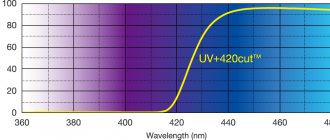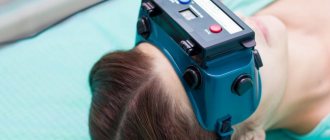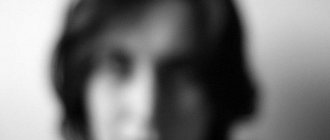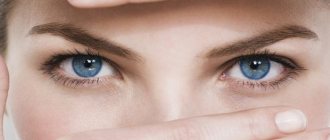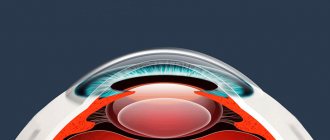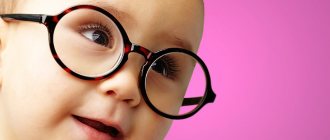Myopia is most common at school age. Every fourth graduate suffers from a decrease in visual acuity to one degree or another. In ophthalmology, the concept of “school myopia” has even been established. Its main reason is stress at school and while doing homework.
Statistics show that the risk of myopia in schoolchildren depends on a set of risk factors and the degree of their influence on the child.
The main parameters that determine the likelihood of developing myopia in children:
Age of onset of vision loss. The earlier myopia first appears, the more active its development will be. The most pessimistic prognosis is for children with impaired vision in early and preschool age.
Gender of the child. Myopia is diagnosed somewhat more often in girls. There is a ratio of about 55/45.
Hereditary predisposition. If parents (both or one) suffer from myopia, the likelihood of developing myopia in a child increases by 3-6 times.
Lifestyle, work and rest schedule. It has been noticed that in passive children, sedentary and trying to avoid any form of activity, the disease is detected more often and progresses three times faster. Nutrition also has a significant impact. The student’s diet must contain a sufficient amount of proteins and carbohydrates, the entire necessary set of vitamins, macro- and microelements. In addition, from childhood it is necessary to teach the child to monitor his posture while writing and reading, ensure sufficient illumination of the workplace, limit the time he watches TV and works at the computer. It is highly advisable to do a warm-up with the student during long sessions while doing homework.
Background diseases. It is necessary to take into account existing diseases that may affect the student’s visual system. Birth injuries and prematurity, spinal cord or brain injuries, acute and chronic infections are essential.
Regular examinations by an ophthalmologist are especially necessary for children with weakened accommodation, congenital astigmatism, anisometropia, etc. Even in the absence of identified diseases of the visual system, all students are recommended to visit an ophthalmologist at least once a year.
Myopia. What it is? Why does it appear in children?
What is myopia? Myopia (myopia) is a pathology in which rays passing through the cornea and lens are focused not on the retina, but in front of it. At the same time, a person with myopia sees objects perfectly only at a close distance, and those that are further away are blurry. One of the reasons for the development of myopia may be heredity, but often this disease is preceded by false myopia. That is, an ailment that appears due to regular overstrain of the eye muscles due to reading, working at the computer and other factors. It is at such moments that the anteroposterior axis of the eye lengthens. As a result, light rays stop focusing on the retina.
Ophthalmologists distinguish several degrees of the disease: first (up to 3 diopters), second (from 3 to 6 diopters) and high - more than 6 diopters. According to the clinical course, myopia is distinguished between static and progressive. The latter is the most dangerous, since it occurs with virtually no symptoms and can only end at the moment when the body as a whole stops growing.
Reading
A somewhat forgotten option for education and self-education, and honor and praise to you, as parents and to your child, if he reads, and not under pressure. But there are pitfalls here: you can’t read either in low light, or vice versa – in very bright light. It is also not recommended to read in normal light near a book, but with darkness around, as is often the case in a dark room with a table lamp focused only on the page with the text.
You need to take it as a rule that for 1 sq.m. The surface of the table should receive illumination equivalent to 15-20 watts. But the best lighting will be natural, from a large window - the main thing is to sit correctly on the right side of it (the left-handed and right-handed rule)
You cannot read in transport - the rocking and vibration of the vehicle will inevitably take the reading area out of sight, the eye will dart after the elusive text and the muscles of the eye, like the muscles that control the focusing lens, will quickly become overtired.
Spasm of accommodation, or false myopia.
As a child grows and develops, more and more eye strain appears in his life. This growth is especially noticeable when children start going to school, and the strain on the eyes increases sharply. Most often, a spasm of accommodation is caused precisely by overexertion. The main reason, as mentioned above, lies in the visual load when working at close range (reading, working at a computer, watching TV for a long time). A number of other reasons also contribute to the development of spasms, which include: a poorly lit workplace, prolonged work with gadgets, lack of daily routine and sports activity, poor nutrition, weak immunity. Some researchers claim that almost every fifth schoolchild complains of myopia. In this case, the child may complain of blurred vision, headaches and pain in the eyes, a sensation of cutting and burning, and the eyes may become red and watery. If your child voices all the above-mentioned unpleasant sensations, immediately go to see an ophthalmologist.
Timely treatment can prevent the development of myopia. It is also recommended to visit an ophthalmologist regularly to prevent myopia.
Note to parents
The number of myopic children in different countries of the world, and often within the same country, varies significantly. In different regions of Russia, myopia is detected in from 2.3% to 13.8% of schoolchildren, and among high school graduates - from 3.5% to 32.2%. The peak age period for the development of myopia is considered to be 10–12 years, although recently the number of myopic children among primary school students has been rapidly increasing.
Experts have found an increase in the number of myopia in northern latitudes compared to southern latitudes and a lower prevalence of myopia among children in rural areas compared to urban ones. An explanation for these factors can be found in the peculiarities of the light regime, nutritional conditions, the time children spend in the fresh air, the degree of visual stress, sports activities, etc.
Symptoms of the disease
Deterioration of distance vision, headaches, including pain in the eyes, as well as burning and stinging can signal the development of myopia. Therefore, you should make an appointment with your doctor. Your child may have false or true myopia. It should be noted that myopia begins to develop precisely at school age, so it is extremely important to visit an ophthalmologist, and also make sure that your child follows some rules for working at a desk during the educational process. This approach is the only correct one for preventing myopia in schoolchildren.
Diagnostics
The effectiveness of treating myopia in children largely depends on the timeliness of seeking medical help. That is why, when you detect the first signs of decreased vision in a child, you should consult a doctor.
When conducting an ophthalmological examination, a specialist may detect the following disorders in a small patient:
- pathology of the macula area;
- thinning of the sclera;
- formation of a myopic cone;
- signs of destruction of the vitreous body;
- retinal detachment, rupture or degeneration;
- hemorrhages.
During the examination, the ophthalmologist can detect not only a significant decrease in visual acuity, but also a spasm of accommodation. This pathological condition is characterized by the appearance of periods of pronounced involuntary stress of accommodation, which makes the eye even more myopic.
When to use Allergodil eye drops: instructions, contraindications, dosages.
You can learn how to choose and use contact lenses correctly from this article.
How to avoid myopia? What to do?
First of all, do not ignore your child’s complaints about feeling unwell or unpleasant sensations. Also make sure that his workplace at home is properly equipped. Look how well lit the space in which the child does his homework: the light should fall from above or to the left. Books or notebooks, as well as a computer, are located at a distance of at least 40 centimeters from the eyes. Under no circumstances should you read a book or do written assignments while lying down. It is worth noting that reading or another type of activity while on the road also affects vision - the eyes become overstrained and become very tired. If a child is in primary school, then the time spent on the computer and gadgets should be limited to a quarter of an hour a day. For preschoolers, the total viewing time of television programs should be up to half an hour a day. If a child has already been diagnosed with myopia, then you should monitor the implementation of all the above measures with a vengeance.
You should definitely include sports in your daily routine, since a stronger body is less susceptible to various types of pathologies, including those associated with vision. Watch what your child eats - the diet should contain proteins, fats, foods rich in calcium, vitamins A, E, C, and selenium. Only an integrated approach will help avoid the development of complications. If the parents have myopia, then you should register with an ophthalmologist immediately after the birth of the child.
Visual hygiene when working with gadgets
Today's schoolchildren actively involve laptops, tablets, smartphones and other gadgets in their educational process. Computer technology has become so firmly established in our lives that we have to set strict restrictions. Forbidding a child to enjoy the benefits of civilization is absurd. However, it is necessary to instill hygiene when working with gadgets.
Try to minimize watching TV, playing on the phone and computer, be sure to take breaks during these activities, just like during reading and homework.
When using a computer monitor, adjust its height. For maximum comfort, place the center of the computer screen approximately 12-20 cm below the horizontal line of sight. The distance from the eyes to the monitor should be at least 50-60 cm.
Myopia in a schoolchild. What to do?
First of all, you need to figure out what kind of myopia we are talking about. If it is small (the first stage) and the number of diopters is no more than three, then there is no need to sound the alarm. Such myopia will quickly disappear as the child grows up if the doctor’s recommendations are properly followed. The main task that a specialist faces when treating myopia is to stop or slow down the progressive deterioration of vision and prevent complications (tears and detachments, retinal dystrophy).
Prevention of myopia progression
Measures aimed at preventing myopia can be carried out even if the child does not have this disease. Ophthalmologists say that a comprehensive approach to the prevention of myopia should be taken. Below we will talk about measures that will prevent the appearance and development of myopia. These include:
- Strengthening the body as a whole, physical exercise. Training that will switch your eyes from one point to another, from close to far, will also be useful. Such games include volleyball, tennis or swimming.
- Functional training and apparatus treatment, video simulators are especially suitable for children.
- Elimination of spasm of accommodation with the help of medications. In addition to the above methods, resort to eye drops that act on the group of fibers of the eye muscle responsible for distance vision (it is weakened in myopia). Typically, such drops are prescribed in courses in the fall and spring during periods of maximum visual load.
Treatment methods for myopia
If a student is diagnosed with myopia, then treatment should be taken seriously. Therapies aimed at reducing spasm and preventing further development of myopia include: taking vitamins and instilling special medications into the eyes, vision correction with glasses or contact lenses, and sometimes surgery. The latter method is resorted to in extreme cases and usually after adulthood, when the growth of the body is complete. As a rule, by this time many children are no longer susceptible to myopia. In addition to these methods, there is also physiotherapeutic treatment, as well as gymnastics. We’ll talk about the latter in more detail, since it is exercises for the prevention of myopia that are recommended by specialists at the treatment stage.
Medical examinations
An examination by an ophthalmologist should be performed at least once a year. And more often when vision deterioration begins. Timely prescribed treatment can both slow down and stop pathological changes in the eyes. Laser correction is possible only after reaching 18 years of age, when the body has already formed and the growth of the soft tissues of the head has stopped.
Keep your child's hands clean and prevent attempts to rub their eyes with unwashed hands - this can introduce dangerous eye infections, such as conjunctivitis or trachoma, into the eyes. In sunny weather in summer or winter (which is often even more important!) Teach your child to wear sunglasses - an ultraviolet burn to the retina is no less dangerous than an infection in the eyes.
Prevention of myopia in schoolchildren
Properly organized prevention of myopia at school age relies on accommodation. This term refers to the process that allows the eye to focus on a specific point in space. To relieve the resulting tension, as well as to support the health of the eye muscles, there is a whole range of exercises. You can do them before bed or during breaks. The main thing is to remember the correct sequence and observe the regularity of this process. Close your eyes and massage your eyelids with your fingers for a few minutes, then sit on a chair and stretch your arms forward. Look at your fingers, as you inhale, raise your hands up without raising your head, follow your fingers with your eyes, and as you exhale, lower your hands. This exercise should be repeated several times. Doctors also recommend making circular movements with your eyes clockwise and counterclockwise, again, several times in one direction and the other.
Another popular exercise in the technique is drawing small circles in the air with your eyes. If circles do not cause interest, then you can choose any other geometric figure. Regardless of the type of exercise, the maximum duration of their execution is no more than three minutes.
All types of prevention for schoolchildren can be carried out at home. You need to understand that the key to this approach is regularity. Only constant exercise guarantees the desired result and effect. Plus, swimming and cycling can be useful. During their execution, the eye muscles experience a different type of load. If false myopia was caused by scoliosis, it is recommended to visit a massage room.
Gymnastics for the eyes
In addition to glasses made of glass or plastic, as well as contact lenses, special sets of eye exercises can also improve vision.
What we offer you should turn into a daily ritual - you need to approach the implementation of this complex so seriously. The exercises are simple, won’t take much time, but their effectiveness is simply fantastic! At least without these exercises, the prognosis for myopia becomes much less favorable.
- You need to imagine in front of you, at a distance of about one and a half to two meters, a large circle, one and a half meters in diameter. You need to run your gaze along this circle, first clockwise, then counterclockwise.
- Slowly move your pupils. Started to the sides, then to the floor to the ceiling. Then do the same exercise with your eyes closed, also to the sides and up and down.
- Jump your gaze from an object about half a meter away from you to one located in the distance. As an option, do this while lying by the window, looking either at the clouds or at the fingers of the hand extended in front of you.
- Blink frequently for about a minute without focusing your eyes on anything in particular.
- Close your eyes tightly, then open your eyes and look at the horizon.
Complex for girls
A special set of exercises for girls aged 12-14 years, who have myopia within 3-6 diopters, and on this basis they received an exemption from general physical education classes. During these years, the female body with its characteristics is formed, and the complex is designed to strengthen purely “female” muscles, especially the pelvis and waist.
- Walking on your heels and toes alternately from half a minute to a minute, with rhythmic, uninterrupted breathing.
- Sipping. Raise your arms up while taking a deep breath. Exhale as you lower your arms. When you inhale, raise your eyes (without lifting your head); when you exhale, lower your eyes down, looking at the toes of your shoes. The exercise is repeated 6-8 times.
- Feet together, arms down. Slowly raising your arms, bring your palms together above your head. Stretch your whole body following your hands - inhale. Lower your arms - exhale, return to the starting position. Follow the thumb with your gaze, first of your right hand, then of your left. Repeat 8 times.
- Place your hands on your belt or fold them behind your head. Alternatively, spread it out to the sides at shoulder width. Arch your back, lean forward, then return to the starting position. When bending over, exhale. At the lowest point of the inclination, make a springy sway.
- Hands on the belt, feet with heels together. Standing on one leg, bend the other at the knee and move it back, trying to touch the buttock with your heel.
- Squat 3 times on your toes, 3 times over the entire area of your feet.
- Training the abdominal muscles and at the same time the eyes: lie comfortably on your back on a flat, elastic surface, spread your arms and spread your legs wide and close them, crossing them. While performing swings, keep your eyes on the tip of the big toe, first on the right and then on the left foot. Repeat 6-8 times.
- Bend your knees and pull them towards your chest - exhale. Straighten - inhale, without taking your eyes off your knees. Repeat 6 times.
- The exercise is performed with an assistant serving the ball: from the starting position lying on your back, grab the rubber ball with your feet, throw it over yourself, without letting the ball out of your sight. This is done 10-12 times.
- Throwing a ball at a wall or a target or a partner. Don't lose sight of the ball.
On weekends, breathing exercises in the forest, in a large city park isolated from the central streets, are useful.
For girls under 12 years of age, the load should be less.
At the end of classes, measure your pulse. 110-120 blows indicate a low, insufficient or too long load. 140-150 blows – average load. An increase in heart rate to 150-170 indicates that the load was correct. But this only applies to children without heart or respiratory defects, so be careful.
Exercise for eye accommodation “Mark on glass”
- Put on the prescribed glasses and stand 40-50 cm from the window. At eye level, put a mark measuring 5-8 mm on the glass.
- Look at the mark, and then look at a distant object in line with this mark. Fix your gaze alternately on the mark and on a distant object for 5-7 seconds. Repeat the exercise 2 times a day for a month. If the accommodative ability of the eyes does not normalize during this time, return to the exercise after 10-12 days and continue until a positive result appears.
- The first two days of classes should last no more than 3 minutes. The next two days - you can already train for 5 minutes. On all subsequent days - 7 minutes. There will definitely be positive results!
- After positive changes, it’s good to play ping pong. Quickly jumping a celluloid ball back and forth and left and right with appropriate serves will further develop the ciliary muscles of the eye and help stop progressive myopia, if it has already occurred. Although it is better to avoid participation in competitions if the degree of myopia is already minus 6 units - physical education teachers in schools have appropriate instructions and authority for this. But you need to continue playing sports independently or under the guidance of a teacher.
- In addition to playing table tennis, the so-called. “penalty” throws with the ball into a basketball basket (an excellent method of coordinating movements and assessing by eye the distance to an object, commensurate with the force of the throw), top and bottom serves in volleyball. Bicycling in the summer, skiing in the winter, and hiking also help a lot, except for carrying heavy loads in your backpack.
Sources used:
- Age-related macular degeneration / S.A. Alpatov et al. - M.: GEOTAR-Media, 2010.
- Prevention of low vision and blindness in children / E.I. Kovalevsky. - M.: Medicine, 1991.
- Treatment of eye diseases. Vision correction. Optics / M.V. Kuropatkina. - M.: Ripol Classic, 2011.
- Department of Ophthalmology | University of Virginia
Prevention of myopia in preschool children
You should also talk about preventive measures for young children who are just starting school. Immediately after the birth of the child, it is necessary to begin doing exercises that are aimed at protecting the organs of vision. Three mandatory visits to a pediatric ophthalmologist are required during the first year of a child’s life: at the end of the third month, then at six months and at one year of age. If one or both parents have myopia, the doctor may prescribe additional examinations, which should not be neglected, since dynamic monitoring of the growth of the baby's eyeball is important.
Particular attention should be paid to lighting in the children's room. The child should not be allowed to play and study in a space with poor light, as this increases the load on the visual system. Also, to avoid eye strain, it is recommended not to let children under three years old watch TV. Older children should limit viewing to half an hour per day.
Recommendations
Currently, ophthalmologists have developed a number of measures to prevent myopia (eye exercises), which can be found on the Internet. They help cope with eye accommodation and prevent the development of myopia, and are also part of the therapy prescribed to children and adults who have already encountered the disease. In addition to general exercises, the doctor may prescribe special ones. Here we are talking about those loads that will be aimed at improving blood circulation in the eye tissues and eye muscles, primarily the ciliary muscle, since it is the one responsible for the development of this disease. As soon as you see signs of myopia in your child, immediately go to the doctor. Do not forget to perform gymnastic exercises for the eyes as a preventative measure.
